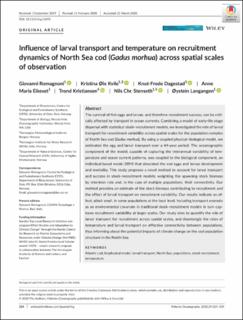| dc.contributor.author | Romagnoni, Giovanni | |
| dc.contributor.author | Kvile, Kristina Øie | |
| dc.contributor.author | Dagestad, Knut Frode | |
| dc.contributor.author | Eikeset, Anne Maria | |
| dc.contributor.author | Kristiansen, Trond | |
| dc.contributor.author | Stenseth, Nils Christian | |
| dc.contributor.author | Langangen, Øystein | |
| dc.date.accessioned | 2020-08-17T12:24:13Z | |
| dc.date.available | 2020-08-17T12:24:13Z | |
| dc.date.created | 2020-07-20T13:36:24Z | |
| dc.date.issued | 2020 | |
| dc.identifier.citation | Romagnoni, GiovanKvile, K. Ø., Dagestad, K. F., Eikeset, A. M., Kristiansen, T., Stenseth, N. C. & Langangen, Ø. (2020). Influence of larval transport and temperature on recruitment dynamics of North Sea cod (Gadus morhua) across spatial scales of observation. Fisheries Oceanography, 29 (4), 324-339. doi: | en_US |
| dc.identifier.issn | 1365-2419 | |
| dc.identifier.uri | https://hdl.handle.net/11250/2672631 | |
| dc.description.abstract | The survival of fish eggs and larvae, and therefore recruitment success, can be critically affected by transport in ocean currents. Combining a model of early‐life stage dispersal with statistical stock–recruitment models, we investigated the role of larval transport for recruitment variability across spatial scales for the population complex of North Sea cod (Gadus morhua). By using a coupled physical–biological model, we estimated the egg and larval transport over a 44‐year period. The oceanographic component of the model, capable of capturing the interannual variability of temperature and ocean current patterns, was coupled to the biological component, an individual‐based model (IBM) that simulated the cod eggs and larvae development and mortality. This study proposes a novel method to account for larval transport and success in stock–recruitment models: weighting the spawning stock biomass by retention rate and, in the case of multiple populations, their connectivity. Our method provides an estimate of the stock biomass contributing to recruitment and the effect of larval transport on recruitment variability. Our results indicate an effect, albeit small, in some populations at the local level. Including transport anomaly as an environmental covariate in traditional stock–recruitment models in turn captures recruitment variability at larger scales. Our study aims to quantify the role of larval transport for recruitment across spatial scales, and disentangle the roles of temperature and larval transport on effective connectivity between populations, thus informing about the potential impacts of climate change on the cod population structure in the North Sea. | en_US |
| dc.language.iso | eng | en_US |
| dc.rights | Navngivelse 4.0 Internasjonal | * |
| dc.rights.uri | http://creativecommons.org/licenses/by/4.0/deed.no | * |
| dc.title | Influence of larval transport and temperature on recruitment dynamics of North Sea cod (Gadus morhua) across spatial scales of observation | en_US |
| dc.type | Peer reviewed | en_US |
| dc.type | Journal article | en_US |
| dc.description.version | publishedVersion | en_US |
| dc.rights.holder | © 2020 The Author(s). | en_US |
| dc.subject.nsi | VDP::Landbruks- og Fiskerifag: 900::Fiskerifag: 920 | en_US |
| dc.source.pagenumber | 324-339 | en_US |
| dc.source.volume | 29 | en_US |
| dc.source.journal | Fisheries Oceanography | en_US |
| dc.source.issue | 4 | en_US |
| dc.identifier.doi | 10.1111/fog.12474 | |
| dc.identifier.cristin | 1819870 | |
| dc.relation.project | Notur/NorStore: NN9297K | en_US |
| cristin.qualitycode | 2 | |

